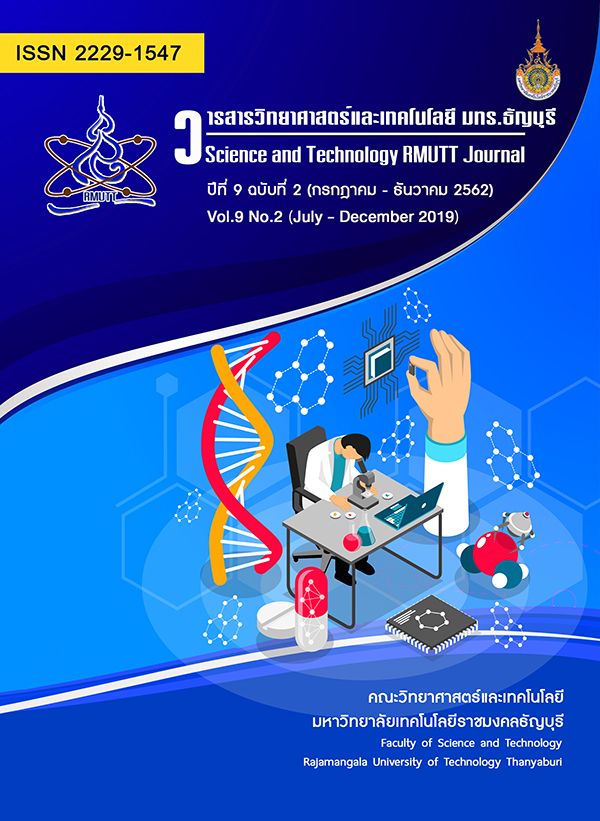Production of Gluten Free Cookies Supplemented with Durian Rind Flour
Main Article Content
Abstract
This research aimed to optimize the formula to produce gluten free cookies supplemented with durian rind dietary fiber. The seven formulations of cookies consisting of durian rind flour (0-20%), wheat flour (30-50%) and salted butter (25-45%) were studied using Mixture Design. Physical properties and sensory evaluation by 30 untrained panelists were investigated. The results showed that weight loss of cookies and spread ratio varied directly as the amount of salted butter. Furthermore, the hardness of cookies tended to increase when the amount of durian rind flour increased. The brightness of cookies varied directly with the amount of wheat flour. Obviously, an optimum formulation of gluten free cookies supplemented with durian rind dietary fiber was 10% durian rind flour, 47.5% wheat flour and 42.5% salted butter, respectively. This formulation had the highest of overall liking scores. Furthermore, using various types of flour replacement with wheat flour was studied. The results discovered that cookies made from mixed flour were the most suitable formula for wheat flour replacement. Apparently, the sensory evaluation score (appearance, texture and overall liking) of cookies made from mixed flour formulas was similar to the wheat flour formula. The development of the flavor and taste of cookies found that the formulated cookies containing green tea powder and coffee powder had an average score of flavor and taste was higher than other formulas. Therefore, gluten free cookies supplemented with durian rind dietary fiber is an alternative product for consumers who want to avoid gluten foods.
Article Details
References
Pakkaew, Y. Durian: King of fruit How to eat for health benefit. Food. 2016. 46: 15-20.
Purnomo, A., Yudiantoro, Y.A.W., Putro, J.N., Nugraha, A.T., Irawaty, W. and Ismadji, S. Subcritical water hydrolysis of durian seeds waste for bioethanol production. International Journal of Industrial Chemistry. 2016. 7: 29-37.
Jun, T. Y., Arumugam, S. D., Latip, N. H. A., Abdullah, A. M. and Latif, P. A. Effect of activation temperature and heating duration on physical characteristics of activated carbon prepared from agriculture waste. Environment Asia. 2010. 3: 143-148.
Ong, S.T., Keng, P.S., Voon, M.S. and Lee, S.L. Application of durian peel (Durio zibethinus Murray) for removal of methylene blue from aqueous solution. Asian Journal of Chemistry. 2011. 23: 2898-2902.
Thai industrial standards institute. Community product standards: cookie (118/2555). Available Source: https://www.tisi.go.th, March 1, 2019.
Shewry, P.R. and Tatham, A.S. Disulphide bonds in wheat gluten proteins. Journal of Cereal Science. 1997. 25(3): 207-227.
Barak, S., Mudgi, D., and Khatkar, B.S. Influence of gliadin and glutenin fractions on rheological, pasting, and textural properties of dough. International Journal of Food Properties. 2014. 17(7): 1428–1438.
Surojanamethakul, V. and Hiraga, C. Coeliac disease & Importance of the gluten-free food. Food. 2013. 43(3): 16-21.
Inchuen, S., Naratippakorn, T., and Khewruang, S. Effect of Holy Basil leaf powder on wheat flour property and cookies quality. Khon Kaen Agriculture Journal. 2018. 46(Suppl.) (1): 1387-1394.
Khumkhom, S. Effect of additional dried sesbania (Sesbania Javanica Miq.) flowers powder on physical, nutritional and organoleptic characteristics of butter cookies. Phranakhon Rajabhat Research Journal (Science and technology). 2018. 13(1): 139-154.
Duncan, D.B. Multiple Range and Multiple F Tests. Biometrics. 1995.11: 1 – 42.
Charoenphun, N., and Kwanhian, W. Effect of flour from durian waste on quality of gluten free pasta. Thai Science and Technology Journal. 2018. 26(5): 803-814.
Kotoki, D. and Deka, S. C. Baking loss of bread with special emphasis on increasing water holding capacity. Journal of Food Science and Technology. 2010. 47: 128-131.
Thai industrial standards institute. Community product standards: durian flour (872/2548). Available Source: https://www.tisi.go.th, March 1, 2019.
Ministry of public health. Announcement-Ministry of public health (No. 209) Cheese. Available Source: http://food.fda.moph.go.th/law/data/announ_moph/P209.pdf, March 1, 2019.
Rattanapanone, N. Food chemistry. Bangkok, Odian store. 504 pp. 2014.
Budzaki, S., Komlenic, D.K., Cacic, J.L., Cacic, F., Jukic, M., and Kozul, Z. Influence of cookies composition on temperature profiles and qualitative parameters during baking. Croatian Journal of Food Science and Technology. 2014. 6(2): 72-78.
Suphamityotin, P. Fruit and vegetable technology. Bangkok, Odian store. 280 pp. 2013.
Bunyasawat, J. and Bhoosem, C. Effect of substitution durian rind powder with wheat flour on tarts quality. RMUTP Research Journal. 2017. 11(2): 48-58.
Pareyt, B. and Delcour, J.A. The role of wheat flour constituents, sugar, and fat in low moisture cerealbased products: a review on sugar-snap cookies. Critical Reviews in Food Science and Nutrition. 2008. 48(9): 824-839.
Bunyasawat, J. and Bhoosem, C. Effect of using durian rind powder substitution with wheat flour on brownies cake quality. RMUTP Research Journal. 2018. 12(1): 113-124.
Sriroth, K. and Piyachomkwan, K. Starch Technology. Kasetsart University Press, Bangkok, 303 pp. 2007.
Pratuangdejkul, A. Orchid ginger. Medicinal plant newsletter. 2009. 26(2): 12-17.
Limpaphayom, V., Laohakunjit, N. Duzzadeelawan, P. and Vamasiri, K. Chemical compositions and antioxidant activity of Zingiber officinale roscoe essential oils. KMUTT Research and Development Journal. 2014. 37(3): 297-312.
Chanapalpun, C., Dhamvithee, P., Jangchud, A. and Boonbumrung, S. Evaluation of the odorants in durian CV. Monthong by GC-TOFMS and electronic nose. Available Source: http://www.lib.ku.ac.th/KUCONF/2555/KC4906027.pdf, March 1, 2019.
Theppakorn, T. Green tea catechins and storage stability. KKU Science Journal. 2013. 41(1): 46-55.
Bunteongjit, D., Green tea. Department of Science Service Journal. 2004. 52(164): 10-14.
Rungsrangtham, N. Changes of volatile compounds in roasted arabica coffee beans during storage. Master’s Thesis. Silpakorn University. 2006.


